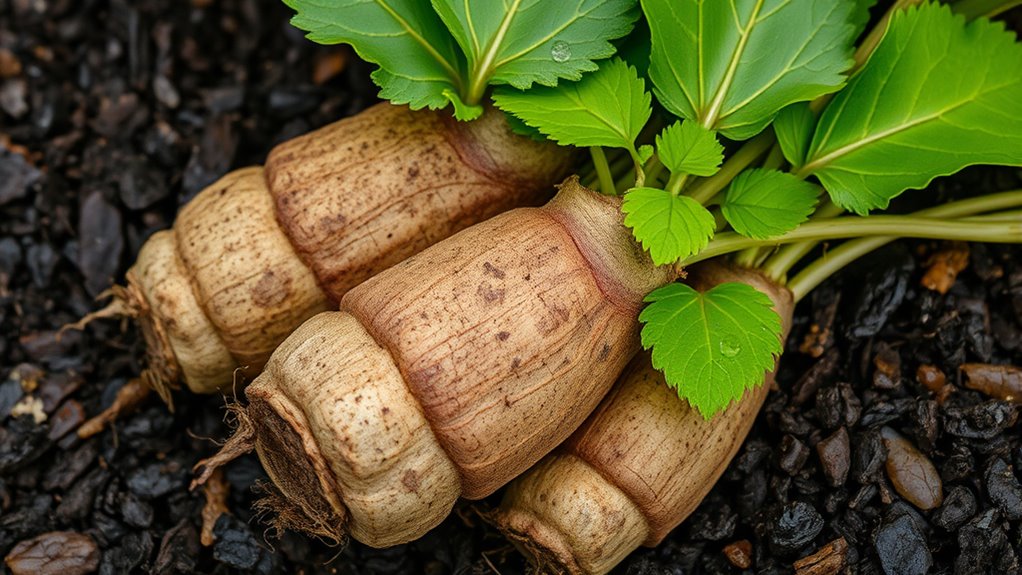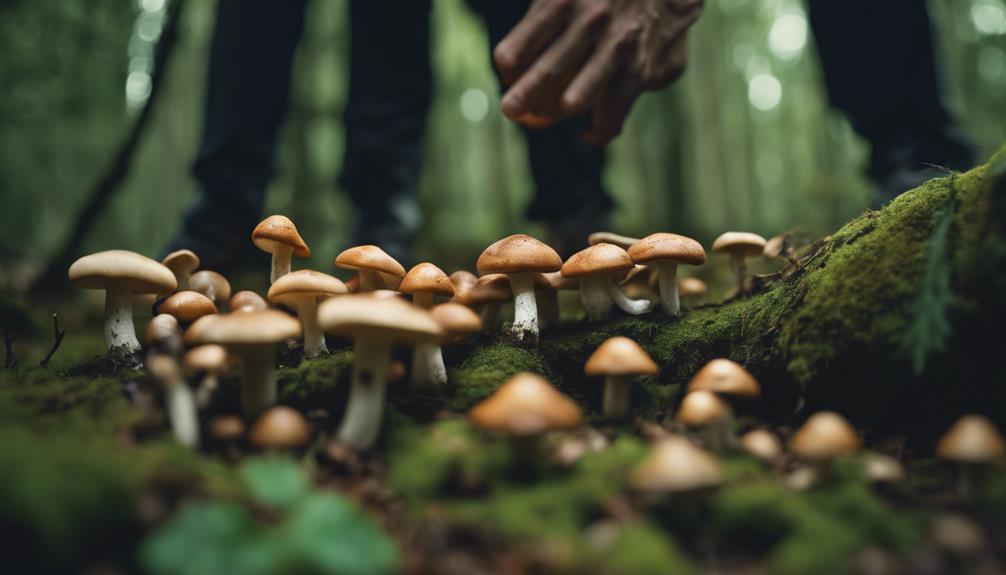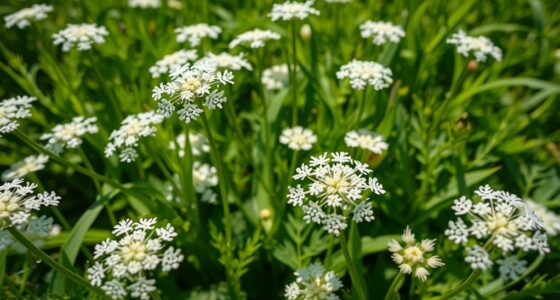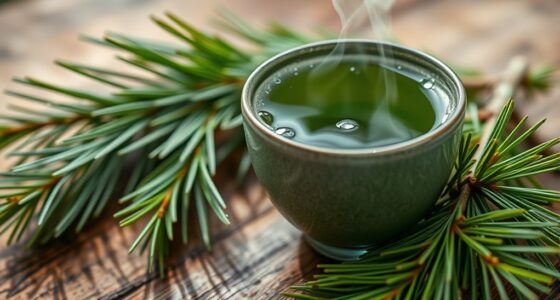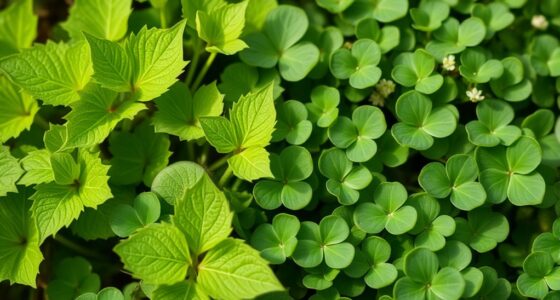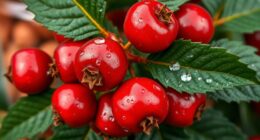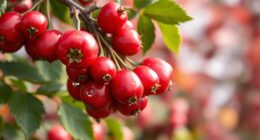Foraging for burdock root is a rewarding activity that offers both tasty and medicinal benefits. Look for large, ovate, heart-shaped leaves with fuzzy undersides, especially along nitrogen-rich, stony soils by roadsides or fields. Harvest roots in late summer or early fall when they’re firm and about the right size, before flowering. Proper cleaning, peeling, and cooking enhance flavor and safety. If you keep exploring, you’ll discover how to select, prepare, and enjoy this versatile, health-boosting root.
Key Takeaways
- Identify burdock by its large, ovate, heart-shaped leaves with fuzzy undersides and waxy tops, growing in nitrogen-rich, stony soils.
- Harvest roots in late summer or early fall when they are firm and before purple flowering begins, using ergonomic tools to minimize effort.
- Thoroughly clean, peel, and soak burdock roots before cooking, and incorporate into dishes like stir-fries, soups, or pickles for flavor and nutrition.
- Burdock roots are rich in antioxidants, anti-inflammatory compounds, and inulin, supporting digestion, immune health, and potentially neuroprotection.
- For safe foraging, correctly identify *Arctium lappa*, avoid contaminated areas, obtain landowner permission, and handle raw roots with care.
Recognizing Burdock in the Wild
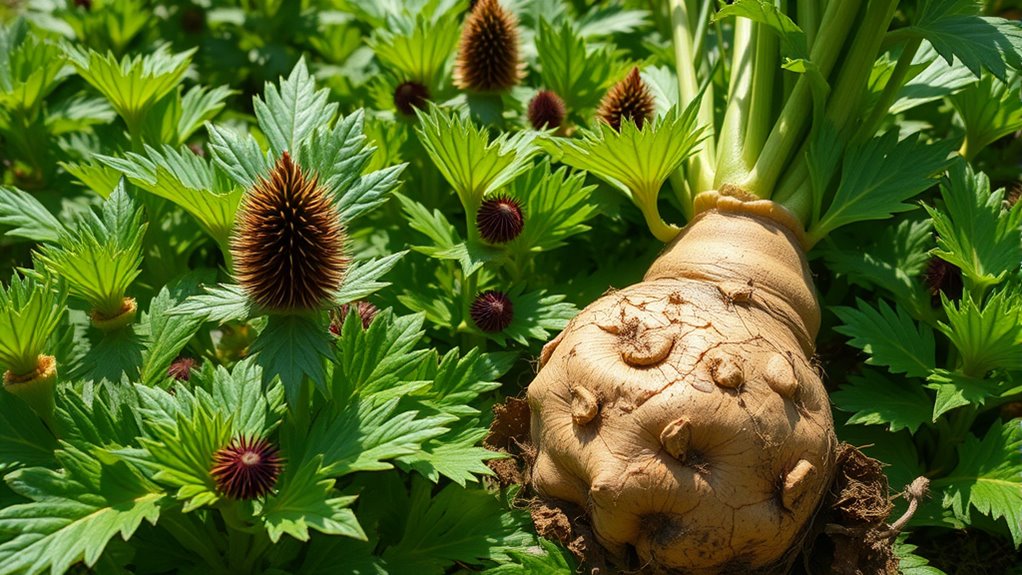
To recognize burdock in the wild, start by examining its distinctive leaves. The leaves are typically ovate, heart-shaped, or egg-shaped, especially at the base. They can grow quite large, reaching 1 to 1.25 meters (3 to 4 feet). The leaves are darker green on top with a lighter, slightly fuzzy underside. The texture is fuzzy or downy beneath, contrasting with a waxy surface on top, and the edges may be entire or slightly toothed. As you look higher on the plant, the upper leaves become smaller and more triangular. Burdock often grows in nitrogen-rich, stony soils along waysides, fields, or in waste ground. Its broad, fuzzy leaves are key identifiers, helping you distinguish it from other wild plants. Visual cues can further aid in identification, especially for beginners.
Best Times and Techniques for Harvesting Roots
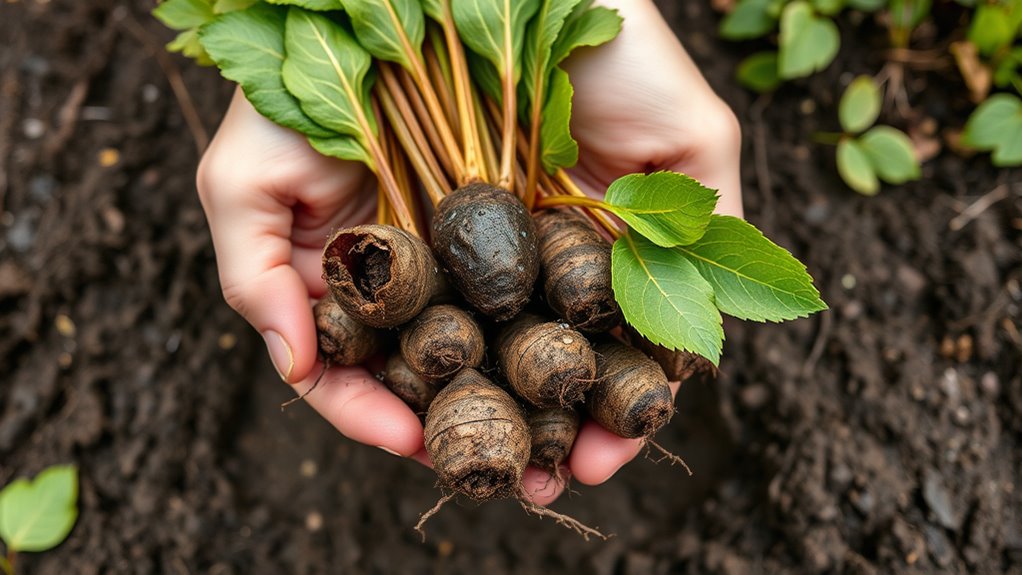
Harvesting burdock roots at the right time guarantees you get the most nutritious and flavorful part of the plant. You should aim to harvest in late summer to early fall, after the roots reach maturity—usually after the first year of growth. Roots are ready when they’re firm, of a desired size, and before the plant produces purple flowers in its second year. Climate influences the timing; in cooler areas, wait a bit longer. Use a sturdy shovel or garden fork to carefully loosen the soil around the root, digging a wide hole to avoid breakage. Gently pry out the root once the soil is loosened. For hard ground, tools like paddles or long-handled implements can help. Proper timing and technique guarantee healthy, flavorful roots for culinary or medicinal use. Additionally, employing ergonomic tools can reduce strain during harvesting, making the process more comfortable and efficient.
Preparing Burdock for Culinary Use
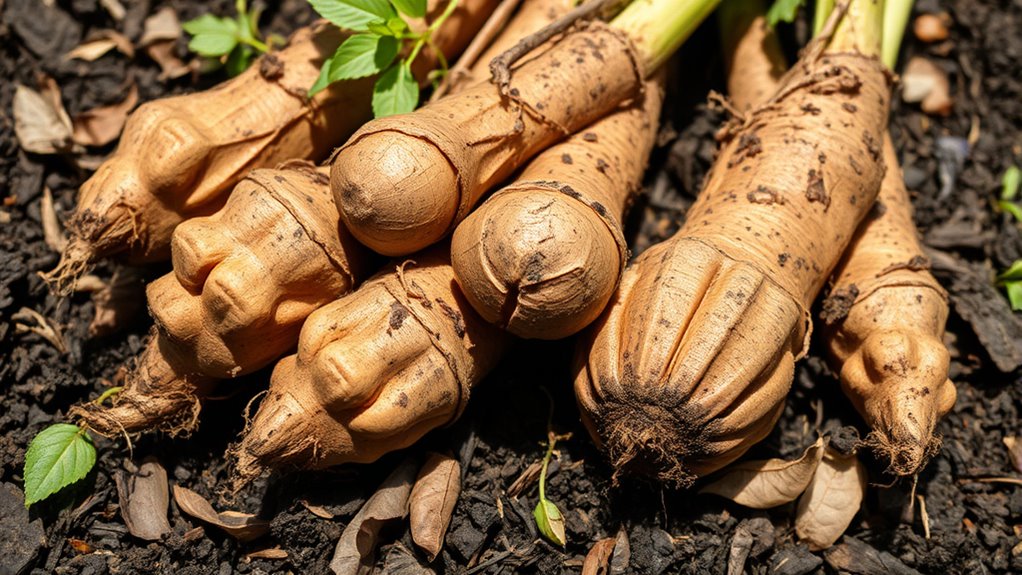
Before cooking burdock root, thorough preparation is essential to guarantee a clean and tender result. Start by washing the roots thoroughly to remove dirt and grit. Peel the skin to improve texture and flavor, then slice the roots into rounds or planks, depending on your recipe. To prevent browning, soak the sliced burdock in water or vinegar. After soaking, pat them dry to avoid sogginess during cooking. Properly prepared burdock can then be roasted, stir-fried, pickled, boiled, or braised. Season with herbs, soy sauce, sesame oil, garlic, or ginger to enhance its earthy, nutty flavor. This careful prep ensures your burdock root retains its texture, flavor, and nutritional value, making it perfect for a variety of delicious dishes. Using safe, durable tools during preparation can further ensure a smooth and injury-free experience. Additionally, selecting tools with effective filtration technology can help keep your workspace cleaner and safer while preparing the root. Furthermore, understanding local foraging tips can help ensure sustainable harvesting practices and the best quality roots. Incorporating proper harvesting techniques can also maximize the health and yield of wild burdock roots, ensuring you gather the most nutritious specimens. Incorporating modern foraging tools can improve efficiency and safety during the harvesting process.
Exploring the Medicinal Benefits of Burdock
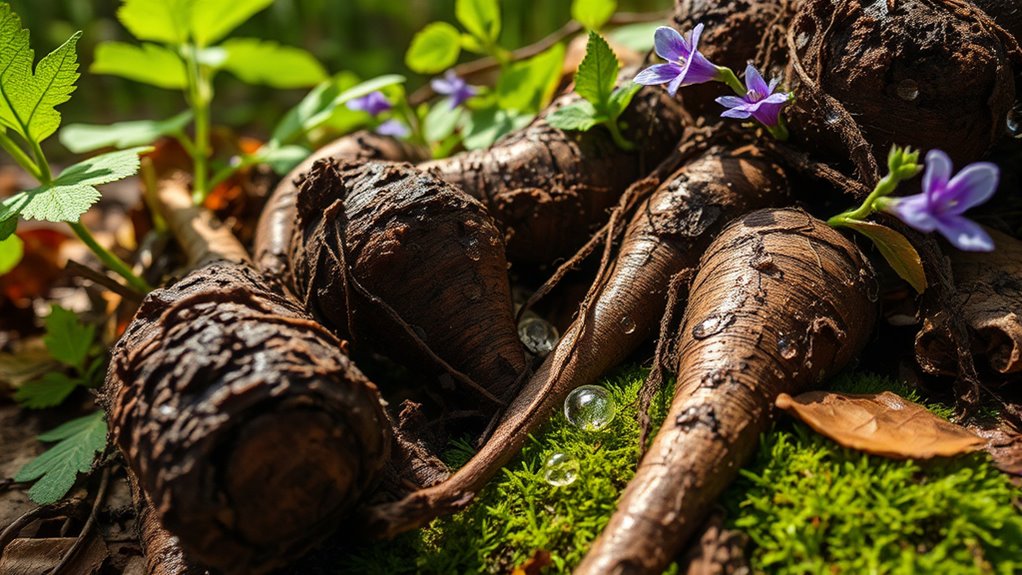
Burdock root is renowned for its wide range of medicinal benefits, supported by its rich array of bioactive compounds. Its antioxidants, like quercetin, phenolic acids, and luteolin, help protect your cells from damage and reduce oxidative stress, lowering the risk of chronic diseases. Additionally, burdock contains nutrient-rich ingredients that can support overall health and boost metabolism. Limited research hints at its potential to slow tumor development and fight inflammation, which can benefit conditions like arthritis and osteoarthritis. Burdock’s flavonoids and polyphenols may also support immune functions that combat cancer. Additionally, its inulin content promotes digestive health by nourishing beneficial gut bacteria and regulating bowel movements. Its anti-inflammatory properties may also help reduce swelling and pain associated with chronic inflammatory conditions. Modern studies suggest that burdock may have potential neuroprotective effects, which could help in preventing degenerative brain diseases. Furthermore, burdock’s detoxifying abilities may assist in cleansing the liver and supporting overall bodily purification. Recent research indicates that burdock may influence blood sugar regulation, contributing to better metabolic health. Systemically, burdock may help control blood sugar, reduce fat buildup, and protect brain cells.
Incorporating Burdock Into Your Meals
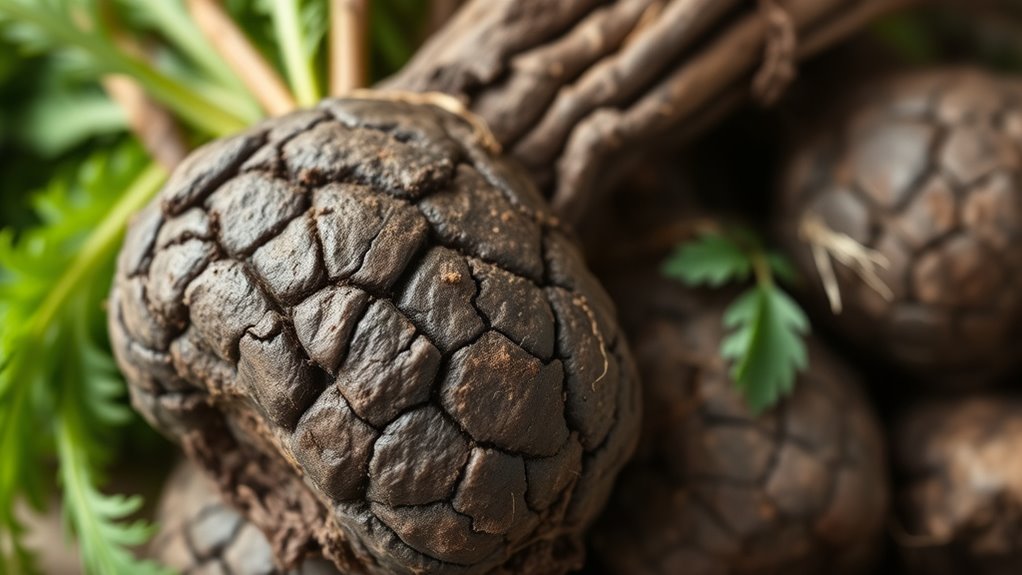
Incorporating burdock root into your meals is an easy way to boost their nutritional value while enjoying its unique flavor and texture. You can add it to soups, stews, and stir-fries for added crunch and richness. Roasting burdock brings out a sweet, smoky flavor, making it perfect as a side dish. Stir-frying with vegetables like carrots, bell peppers, and herbs such as ginger or sesame oil enhances its natural earthiness. Pickling burdock creates tangy accompaniments for rice bowls or salads. Raw or roasted, burdock adds a satisfying texture and nutritional boost thanks to its high vitamins, fiber, and antioxidants. Additionally, experimenting with different cooking methods can help you maximize the retention of its nutrients, especially when using organic cultivation techniques.
Enjoying burdock’s versatility and health benefits in everyday meals becomes easier when you understand its growth and harvesting process, ensuring you select the freshest and most nutritious roots.
Safety Tips for Foraging and Consumption
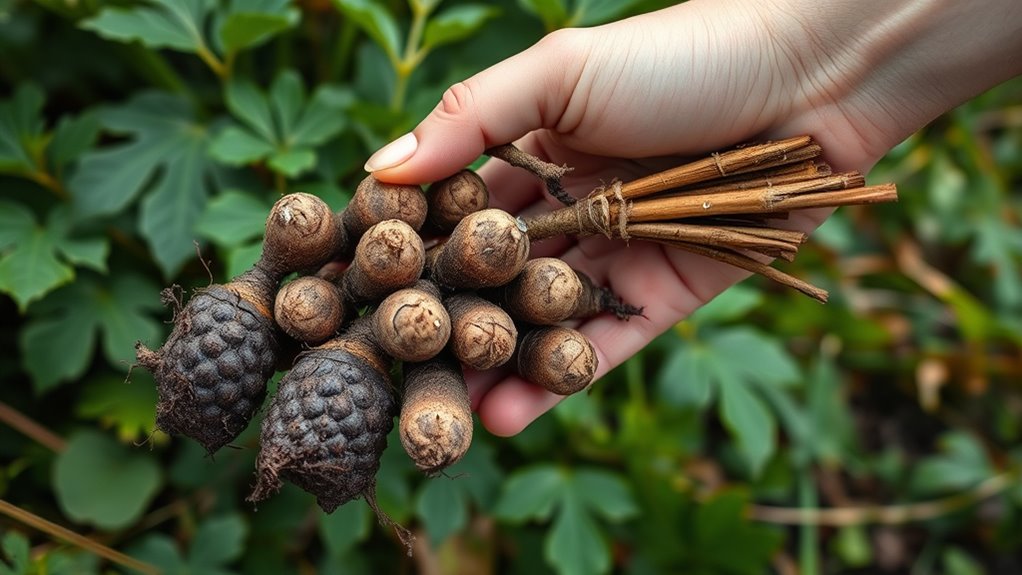
Ensuring safety while foraging and consuming burdock root is essential to avoid health risks and legal issues. First, always correctly identify *Arctium lappa* to prevent confusion with harmful lookalikes.
Harvest roots in early spring or late fall for the best flavor and medicinal benefits. Obtain landowner permission before digging to stay within legal boundaries. Avoid collecting near industrial sites, roads, or contaminated areas to prevent chemical exposure.
Use appropriate tools like shovels or trowels to dig carefully, minimizing damage. Thoroughly wash the roots to remove dirt and pathogens, inspecting for damage or mold before eating.
Start with small portions to check for allergic reactions, and cook raw roots to improve digestibility. Wear gloves and protective gear during handling for added safety.
Understanding the significance of symbols in dreams can help interpret subconscious messages that may relate to your personal safety and well-being during foraging activities.
Frequently Asked Questions
Can Burdock Roots Be Harvested Sustainably Without Damaging the Environment?
You can harvest burdock roots sustainably by following best practices. Gently loosen the soil to avoid damaging the plant or surrounding soil, and only take mature roots during late summer or early fall.
Leave some plants unharvested to ensure they seed and maintain populations. Additionally, consider cultivating burdock in your garden to reduce wild habitat pressure.
Always monitor local plant health to prevent overharvesting.
Are There Any Common Look-Alikes to Avoid When Foraging for Burdock?
When foraging for burdock, you need to watch out for common look-alikes. Curly dock has large, smooth leaves without burs.
Houndstongue produces small burs and is toxic.
Foxglove looks similar early on but has arrow-shaped leaves and scraggly roots.
Rhubarb has red-tinged stems, and thistles have spiky features.
Proper identification is key to avoid dangerous mistakes, so always check leaf shape, burs, and growth habitat carefully.
How Can I Tell if a Burdock Root Is Fresh and Suitable for Eating?
When it comes to picking burdock root, you want to see it in its prime, like a gem waiting to shine. Look for roots that are firm, with a creamy white or light brown color, free from dark spots or mold.
Smell for a mild, earthy aroma—nothing sour or unpleasant. Make certain it’s not soft or shriveled, and store properly to keep it fresh.
What Are the Best Storage Methods for Harvested Burdock Roots?
You want to know the best ways to store harvested burdock roots. To keep them fresh, refrigerate in the crisper wrapped in a damp cloth or sealed bag, maintaining high humidity.
For longer storage, freeze after blanching, dry completely, or grind into powder. Use airtight containers to prevent moisture and pests, and handle roots gently to avoid bruising.
Store in a cool, dark place if refrigeration isn’t available.
Are There Any Known Allergic Reactions Associated With Burdock Consumption?
You should know that burdock consumption can trigger allergic reactions if you’re sensitive to the Asteraceae family, which includes ragweed and daisies. Symptoms like rashes, hives, and itching may occur.
In rare cases, severe reactions like anaphylaxis happen. To stay safe, consult your healthcare provider before trying burdock, especially if you have allergies.
Avoid consumption if you’re prone to plant allergies and seek prompt medical help if you notice symptoms.
Conclusion
Now that you know how to identify, harvest, and enjoy burdock root, you’re ready to incorporate this nutritious plant into your diet. Did you know that burdock has been used medicinally for over 1,000 years in traditional practices? With its rich history and health benefits, foraging for burdock can become a rewarding part of your culinary and wellness routines. Just remember to follow safety tips, and you’ll reap the tasty and medicinal rewards of this versatile root.

